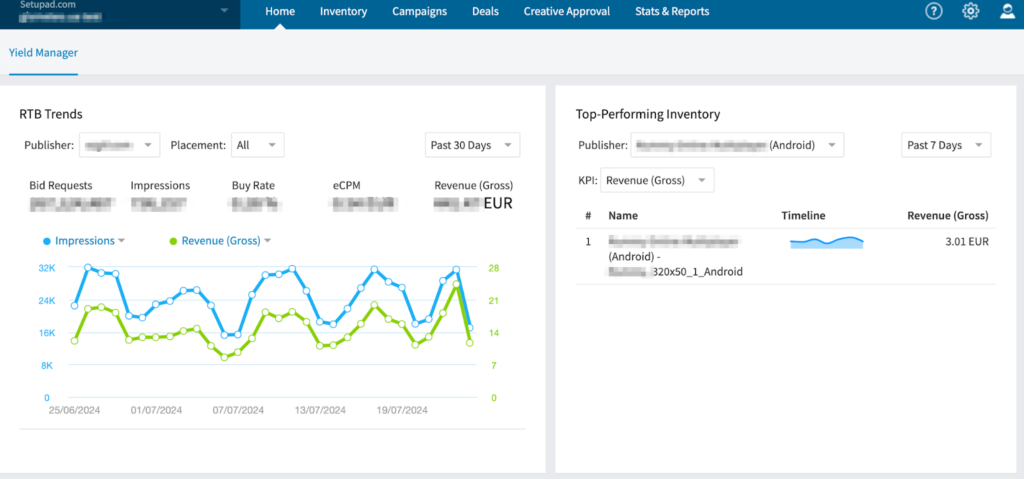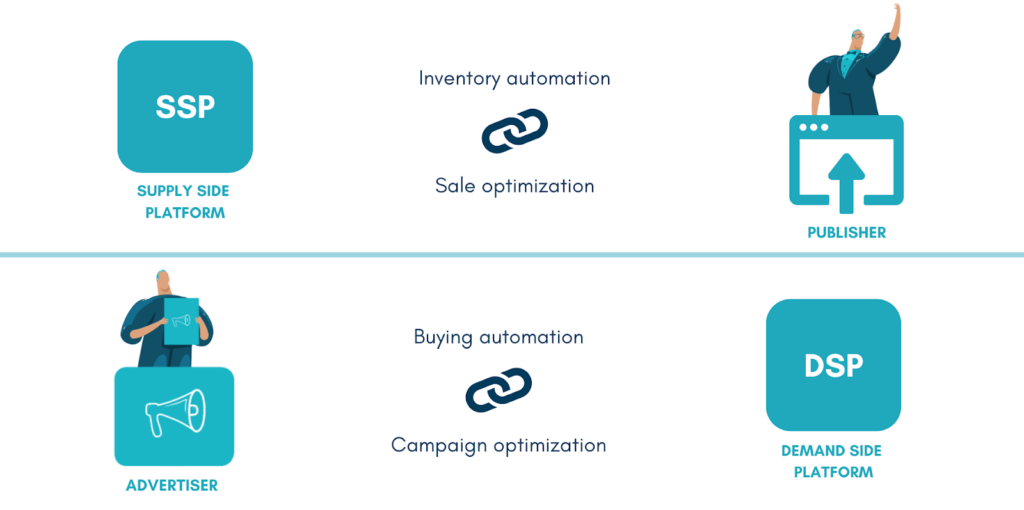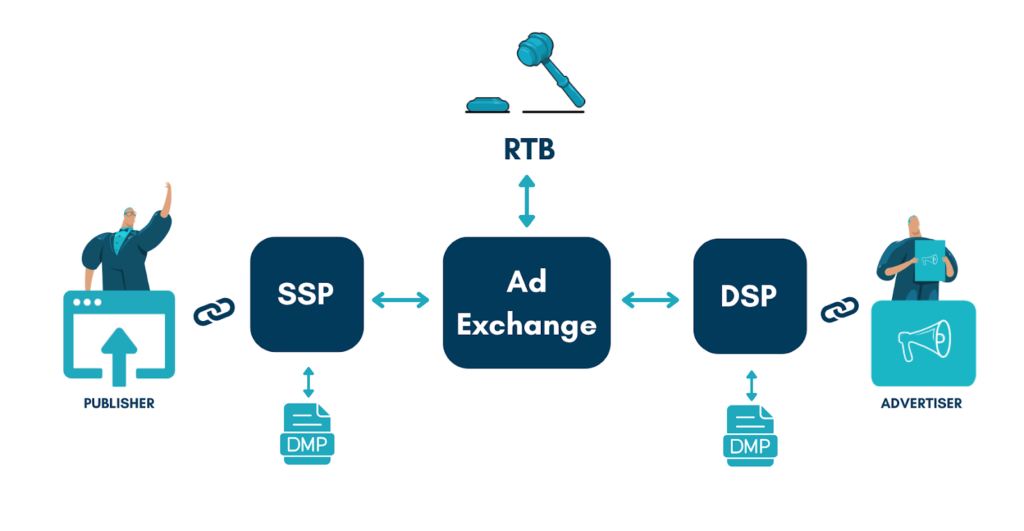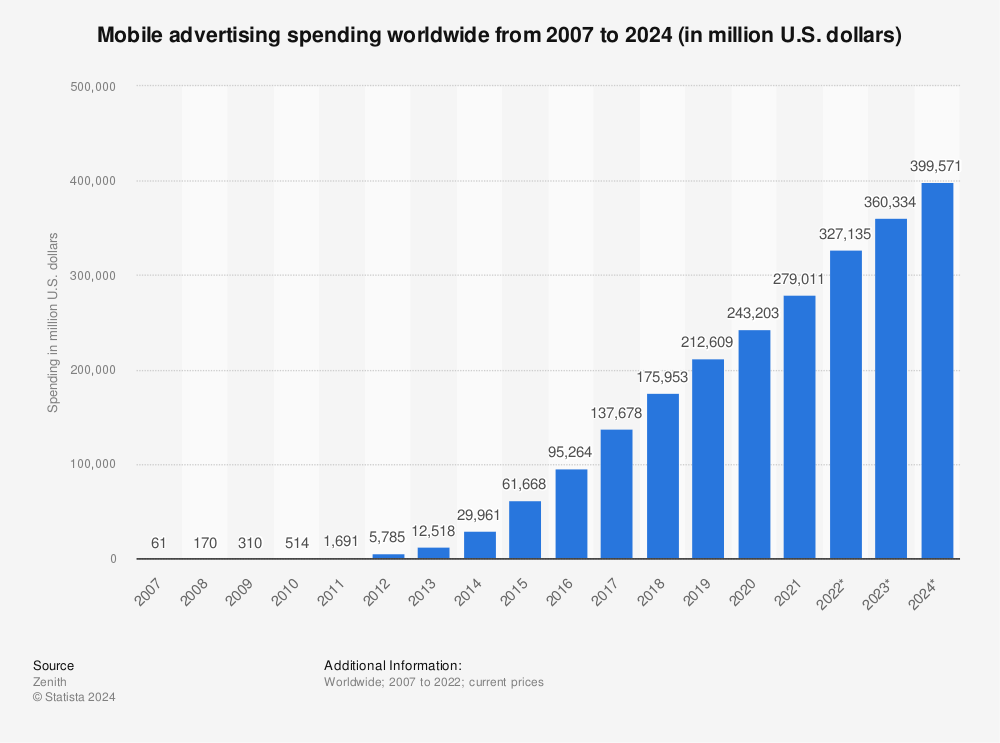What is a Supply-Side Platform (SSP)? Current Market Outlook
In the complex and rapidly evolving world of digital advertising, Supply-Side Platforms (SSPs) play a pivotal role. SSPs enable publishers to manage, sell, and optimize their ad inventory efficiently and effectively through automation.
This article explores the key components and functions of SSPs, their integration with other ad tech, and strategies they use to ensure optimal revenue outcomes for publishers.
What Are Supply-Side Platforms (SSPs)?
A Supply-Side Platform (SSP) is a technology platform that enables web publishers and digital media owners to manage, sell, and optimize their available ad inventory in an automated and efficient manner. SSPs connect directly to ad exchanges and demand-side platforms (DSPs), facilitating the real-time bidding (RTB) process for ad impressions.
The first SSP to ever appear in programmatic advertising was Pubmatic, founded in 2006. Prior to this technology and the invention of real-time bidding protocol, ad trade was facilitated manually.
Key Components of a Supply-Side Platform
Ad inventory management
SSPs provide tools for publishers to manage their ad inventory, including defining ad units, setting floor prices, and organizing inventory into segments that can be sold to advertisers.
Real-time Bidding (RTB)
RTB is a core feature of SSPs, allowing ad impressions to be sold via automated auctions in real-time. This ensures that publishers can maximize their revenue by selling impressions to the highest bidder at the exact moment an impression becomes available.
Integration with ad exchanges and Demand-Side Platforms (DSPs)
SSPs seamlessly integrate with multiple ad exchanges and DSPs, broadening the pool of potential buyers and increasing competition for ad inventory.
Reporting and analytics features
Comprehensive reporting and analytics are vital components of SSPs, providing publishers with detailed insights into ad performance, revenue, and inventory usage. However, it’s important to note that each SSP has its own unique tools and features. Some might offer more user-friendly dashboards or advanced reporting tools and some might focus on other elements.
Below is an example of Adform’s dashboard.

SSP’s Role in Digital Advertising
The primary goal of every SSP is to help publishers maximize the revenue they can generate from their digital properties through advertising.
How SSPs Work?
While the specific features of SSP may vary, they generally follow a similar process:
- Publishers connect their digital assets, such as websites and apps, to the SSP by either installing its software development kit (SDK) or embedding its code into their platforms.
- Publishers configure their ad inventory within the SSP, detailing available ad placements, formats, targeting options, and pricing rules.
- When a user accesses a publisher’s site or app, an ad request is sent to the SSP. These requests include information about the available ad impression, such as user demographics, behavior, and contextual data. The SSP then initiates a real-time auction, inviting DSP, ad exchanges, and advertisers to place bids on the available ad inventory. This process typically completes within milliseconds.
- DSPs and advertisers review the ad request data and submit bids based on their targeting criteria, budgets, and campaign objectives. The SSP evaluates these bids and selects the highest one as the auction winner.
- Following the bid selection, the SSP instructs the publisher’s ad server to deliver the winning ad creative to the user’s device.
Benefits of Using an SSP
1. Revenue Maximization for Publishers
SSPs facilitate real-time bidding, allowing multiple advertisers to compete for ad space. This competition often results in higher bids and increased revenue for publishers. Besides, if SSP can dynamically adjust floor prices based on market demand and user behavior, they ensure that ad impressions are sold at optimal prices, maximizing revenue potential.
2. Increased Ad Fill Rates
SSPs connect publishers to various ad exchanges, DSPs, and often direct buyers, broadening the pool of potential advertisers and increasing the likelihood of filling all available ad inventory.
3. Enhanced Targeting Capabilities
SSPs leverage first-party and third-party data to create detailed user profiles, enabling precise audience segmentation and targeted ad delivery. Furthermore, by analyzing user behavior and content context, SSPs can serve more relevant ads, improving user engagement and ad effectiveness.
4. Improved Operational Efficiency
SSPs automate the process of managing and selling ad inventory, reducing the need for manual intervention and allowing publishers to focus on other activities. With detailed analytics and reporting, they offer essential insights into ad performance and revenue metrics.
Related Article: Top Supply Side Platforms (SSPs) for Publishers for 2024
Integration of SSPs with Other Ad Tech
SSPs and DSPs
SSPs and DSPs work in tandem to facilitate the buying and selling of ad inventory. While SSPs manage the supply side, DSPs represent the demand side, offering sophisticated targeting options, real-time bidding capabilities and campaign management tools to help advertisers achieve their campaign objectives.
To summarize, SSPs are primarily responsible for inventory automation and sale optimization, while DSPs – for buying automation and campaign optimization.

Integration with data management platforms (DMPs)
SSPs often integrate with DMPs to enhance targeting capabilities. DMPs collect and analyze user data, which SSPs can use to provide more precise targeting options to advertisers. In the evolving digital landscape, DMPs are increasingly focusing on first-party data collection.
Related Article: Agency SSP as a New Channel to Advance Publisher-Advertiser Synergy
The role of ad exchanges
Ad exchanges act as marketplaces where SSPs and DSPs interact. They facilitate the RTB process, ensuring that ad impressions are sold to the highest bidder in a transparent and efficient manner.
Below is a basic view on how these parties integrate together.

Challenges Faced by SSPs
Competition and market saturation
The SSP market is highly saturated, making it difficult for platforms to stand out. With numerous SSPs offering similar functionalities, differentiation becomes crucial for attracting and retaining publisher clients.
Differentiating through unique offerings such as exclusive access to premium inventory, tailored customer support, and specialized ad formats (like video and mobile-specific ads) helps SSPs stand out in a crowded market.
As an example, The Trade Desk’s OpenPath now allows direct transactions between advertisers and publishers, potentially bypassing SSPs. This move forces SSPs to demonstrate their value beyond just facilitating transactions by offering added benefits such as enhanced targeting and yield management.
The rise of direct relationships between advertisers and publishers, often facilitated by DSPs, poses a significant threat to SSPs. Disintermediation eliminates the need for intermediaries, such as SSPs, reducing their role and revenue potential.
For example, SSPs like Magnite and PubMatic have introduced products such as ClearLine and Activate, respectively, which enable direct interactions with buyers while still leveraging SSP technology for yield optimization and transparency.
Ad fraud and its impact on SSPs
Ad fraud presents another significant challenge for SSPs. It therefore becomes more important than ever to optimize supply paths to reduce the number of intermediaries and potential fraud points. Many SSPs also obtain certification such as Trustworthy Accountability Group (TAG), which sets standards for combating ad fraud.
The Role of SSPs in Mobile Advertising and Video Advertising
Mobile Advertising
Mobile SSPs offer features tailored to the unique needs of mobile advertising. Here are 5 key mobile-specific SSP features:
- In-App Advertising Support
Easy integration of ad serving capabilities into mobile apps via SDKs and support for various mobile ad formats like banners, interstitials, native ads, and rewarded videos.
- Geolocation Targeting
Utilization of device GPS data for accurate geolocation targeting, enabling effective local advertising.
- Responsive Ad Formats
Ads that adapt to different screen sizes and orientations, ensuring a consistent user experience across mobile devices.
- Advanced Targeting Capabilities
Leveraging first-party and third-party data for detailed audience segmentation and targeting, as well targeting ads based on user behavior and app context.
- Ad Mediation
Tools to prioritize and serve ads from multiple networks, optimizing fill rates and CPMs.
Growth in Mobile Ad Spend
The rapid increase in mobile device usage has led to a significant rise in mobile ad spend. According to Statista, mobile ad spending is expected to account for almost $400 million, emphasizing the importance of SSPs in this segment.
Mobile SSPs like AdMob and MoPub help publishers capitalize on this growth by effectively monetizing their mobile inventory.

Video Advertising
SSPs Tailored for Video Ad Inventory
Video SSPs like SpotX and Magnite handle multiple formats, including pre-roll, mid-roll, post-roll, and outstream ads, as well as support for various video formats including in-stream, out-stream, and connected TV (CTV).
These platforms offer sophisticated targeting options based on user demographics, behavior, and content consumption patterns and support various video-specific features, such as dynamic ad insertion.
Trends in Video Advertising
The rise of CTV and OTT platforms and interactive video ads has transformed video advertising. SSPs have adapted by offering solutions tailored to these environments, enabling programmatic ad buying in streaming content.
Revenue Optimization Strategies with SSPs
Dynamic price floors
Unlike static price floors, which set a fixed minimum price for ad impressions, dynamic price floors adjust in real-time based on various factors such as demand, user behavior, and market conditions.
SSPs can use machine learning to predict the value of impressions, optimizing bidding strategies and floor prices dynamically.
Audience segmentation
SSPs optimize audience segmentation to enhance ad relevance and maximize revenue for publishers by integrating first-party and third-party data to create detailed user profiles.
They use machine learning to predict user behavior and dynamically update segments in real-time, ensuring ads remain relevant. Additionally, SSPs leverage contextual and behavioral targeting to align ads with user interests and browsing habits, and they integrate with DMS to create unified customer profiles and refine audience segments continuously.
Related Article: What is Audience Segmentation? 8 Main Types and Tips
Ensuring Ad Quality and Relevance
Brand safety measures
SSPs ensure ad quality and relevance through comprehensive brand safety measures. They may implement ad verification processes and tools like DoubleVerify and IAS to filter out inappropriate or harmful content and use advanced fraud detection tools to maintain inventory integrity. SSPs also provide detailed reporting and transparency, allowing publishers and advertisers to monitor ad placements and ensure compliance with brand safety standards.
Viewability standards
SSPs ensure ad quality and relevance utilizing industry-wide viewability standards, such as those set by the IAB/MRC to monitor ad impressions and ensure ads appear in visible locations.
The latest guidelines suggest that actual visibility is measured via viewable impressions, with display ads requiring 50% of pixels visible for 1 continuous second and video ads needing 50% visibility for 2 continuous seconds. SSPs also employ real-time analytics and reporting to optimize ad placements for maximum visibility.
Conclusion
SSPs play a central role in the digital advertising ecosystem, offering a comprehensive suite of tools to optimize ad placements and performance. As the industry continues to evolve, SSPs face challenges such as market saturation and ad fraud, yet remain crucial in enhancing ad quality and relevance through rigorous verification processes and viewability standards. By continuously innovating and adapting, SSPs ensure that publishers can navigate the complexities of digital advertising and achieve optimal revenue outcomes.
Frequently Asked Questions (FAQs)
What is a supply-side platform?
A supply-side platform (SSP) is a technology platform that helps publishers manage, sell, and optimize their ad inventory through automated and efficient processes.
How do SSPs make money?
SSPs typically make money by taking a percentage of the ad revenue generated from selling the publisher’s ad inventory.
What is the difference between an SSP and an ad exchange?
An SSP helps publishers manage and sell their ad inventory, while an ad exchange is a marketplace where ad impressions are bought and sold.
How does real-time bidding work in SSPs?
In real-time bidding (RTB), SSPs send bid requests to multiple ad exchanges and DSPs. Advertisers bid for the impression in real-time, and the highest bid wins.
Are SSPs necessary for small publishers?
While SSPs offer significant benefits, small publishers may weigh the costs and benefits based on their specific needs and resources.
What are the risks associated with using an SSP?
Risks include ad fraud, data privacy issues, and potential revenue losses due to improper management of ad inventory.
How can publishers choose the right SSP?
Publishers should consider factors such as technology capabilities, integration options, support services, and reputation in the market when choosing an SSP.


